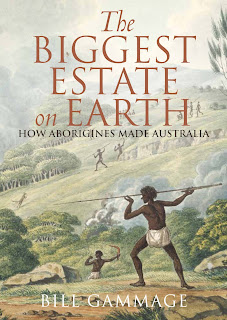The Biggest Estate on Earth
 The Biggest Estate on Earth: How Aborigines Made Australia, by Bill Gammage
The Biggest Estate on Earth: How Aborigines Made Australia, by Bill GammageThis book wins the prize for Most Mind-Blowing Book of 2017 So Far. Way back during Brona's AusNovember event, she posted about this book, and obviously I was going to have to read it. I don't really know diddly-squat about Australian history, except for a vague impression of hunter-gatherer Aborigines decimated by British colonialism/prison settling. I certainly did not know that the Australian landscape of 1788, when the First Fleet arrived from Britain, was a very different place than it is now.
The native Australians were running the entire continent as a vast...park. Like a "gentleman's estate in England" kind of park, with lots of grassland and trees scattered about, with places for game to feed and multiply. They had every inch of the land covered and took care of all of it, encouraging different habitats and plant varieties in carefully planned patterns. Thousands of years of cumulative knowledge gave them the expertise to manage the land so that game was plentiful but not too much, and water was conserved in soil. Then they could travel over the land and always be assured of enough for all, even in terrible droughts: "Across Australia the end was the same: to make resources abundant, convenient and predictable. Only the means varied." They accomplished all of this with several tools, but largely with expertly-wielded fire.
European settlers took the parkland as natural, describing it in detail and often comparing it to an English estate park. Few realized that the Aboriginal habit of burning was a land-management technique -- though they did know that burning grass encouraged new growth for grazing -- and hardly anyone seems to have understood the breathtaking extent of the work. Modern Australians have usually taken the early paintings of bucolic Australia to be exaggerations, but they weren't.
 |
| It actually did look like this |
When the land-management patterns were disrupted, soil became compacted, water drained off, and most of all, new trees and spinifex took over. The brush wildfires that now occur in Australia on a regular basis are new; Aboriginal fire management once prevented them.
Gammage proves his case exhaustively, using (apparently) every early painting and map, photos, and descriptions to compare 1788 to today. He reels off names of trees, shrubs, and grasses until you're dizzy, and he seems to know exactly what each of them needs. Many of the tree names, unfamiliar to a non-Australian, confused me at first, until he explained that most of them are either types of eucalyptus or types of acacia (golden wattle is one of those). It's a long, heavy, and fascinating book, so it took me quite a while to read, and his thesis is hard to deny.
The result of this land management system was abundance. Early settlers noticed, and resented, that Aborigines acted like leisured gentry. "In most seasons they had plenty of spare time....Art was voluminous and intricate...Songs were long, corroborees might last months, initiations years." Not only that, but part of the system was that in times of plenty, much was left to the animals, while people made sure to act like they were in a drought. Their methods ensured that they could just about always avoid famine.
Aboriginal Australians invented a land management system for which we barely even have a name. They planted crops, hunted, and gathered, but they did it in a framework that took in every corner of the continent. Every bit was known by some family. I don't think anything like it has ever happened anywhere else.
So: a lot of fascinating history here. Gammage is exhaustive, but it's very worth a read.




I've heard about this in North America too. Especially in the forest of the eastern half. It is amazing.
ReplyDeleteCalifornia natives managed oak trees in a similar way, too. So land management happened, and probably in many places and cultures. It was more the part where *every bit* of land was managed that I found really stunning.
ReplyDelete